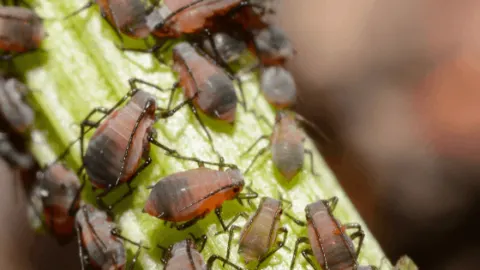Aphids are creepy little creatures with back legs like a cricket. It’s those back legs and their pear body that make it easy to differentiate them from most other plant pests.
These bugs move slow but they multiple fast. Before you even know you have a pest problem, aphids have taken over your poor plants. In this article, we focus on Aphids and how to get rid of them forever!
I personally had several instances where I successfully fought these pests and won. This is not always the case when fighting pests, unfortunately.
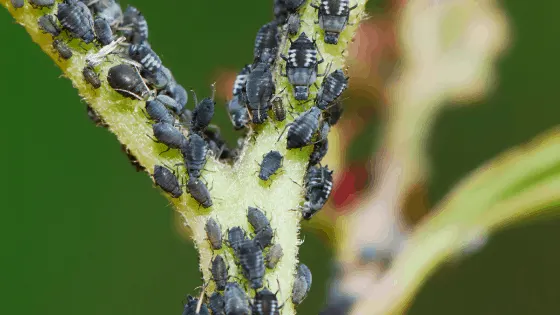
You want to avoid aphids. Only a few of these bugs won’t harm your plant.
When the infestation grows, your plant will get ill. Aphids can even kill it by stealing everything your plant needs to thrive.
They do this by stealing the sap in your plants.
All without you ever knowing what’s going on. At least, not until there are aphids clustered all over your plant.
On the bright side, an aphid infestation doesn’t have to dominate your houseplants. They’re pretty easy to exterminate before they do any real damage.
We’re going to learn all about these pests that are aphids, from the basics to how they affect your plant.
Then we’re going to get serious. We’re going to learn exactly how to get rid of these pesky pests.
If you are looking to get rid of mealybugs instead, please have a look at our extensive mealybugs guide.
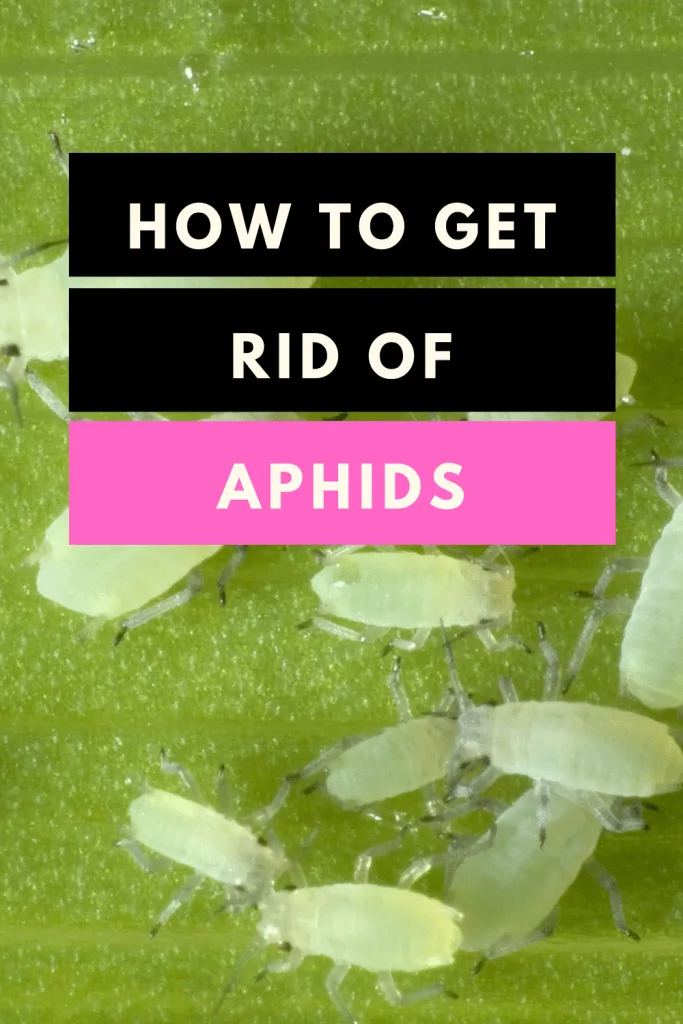
How to get rid of Aphids
Table of Contents
What are Aphids?
Aphids are super small bugs, making it hard to see unless you’re looking for them. They don’t get bigger than 1/4 of an inch.
They come from the Aphidoidea family.
Aphids are soft-bodied bugs. Their bodies are shaped like a pear and they have long antennas.
They use long slender mouths to pierce the plant they’re feeding on. This looks like a tube protruding from their front.
There are also strange tubes called cornicles. These tubes protrude from their back end. It’s the cornicles that distinguish aphids from other pests.
They also have back legs that bend like a cricket’s legs. This is another one of their features that make them different from most other bugs.
Aphids come in several colors including black, brown, gray, green, pink, white, and yellow. There are even aphids that you can see through.
The nymphs, or young aphids, are hard to tell from the adults. They look the same as full-grown aphids, only on a smaller scale.
There are aphid species that are waxy or even have a cotton-like coating like mealybugs.
One of these species is the white woolly aphid. They create their coating with their very own secretion.
There are a couple of aphid species that develop wings when they live in a populated area. This allows them to fly elsewhere to feed and colonize when sap becomes scarce.
This is how an infestation starts. A few winged aphids are looking for a plant to colonize.
When they find the perfect plant, they drop off young aphids so they can start feeding and breeding.
Aphids aren’t the fastest bugs in the world. This comes in handy later on when you treat your plant.
The majority of aphid species are attracted to all plants. Though succulents are a favorite for most sapsuckers.
There are several species of aphids. In fact, there are over 4,000 species.
But only 250 of these species attack crops and plants in the United States.
Some of the species include bean aphids, cabbage aphids, melon aphids, and potato aphids. Each one of these species is named after the plants they feed off of.
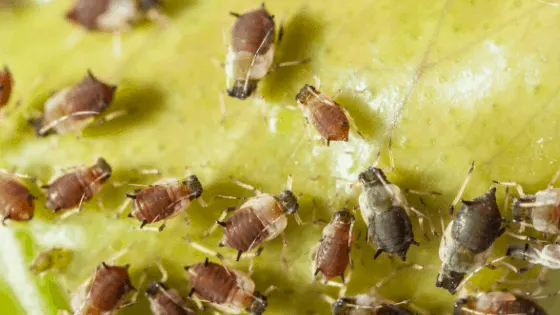
Aphid infestations can threaten the health of your plant
How Aphids Reproduce
Aphids reproduce fast. They do this for their protection. They’re very small creatures.
So, when a predator comes along, they can’t fight back. But if they outnumber the predator, they have a better chance of survival.
There are aphid species that reproduce sexually. And there are aphid species that reproduce asexually. There are even species that reproduce using both methods.
Every female aphid lives up to 25 days. But during that mere 25 days, they can produce close to 80 aphids.
They create several generations in one mating season.
Once spring has hit, the aphid eggs hatch. Every one of these eggs will produce a female.
The nymphs immediately find a place to feed. And as they get bigger, they start to molt. Molting is when they shed their skin.
The bugs will go through this process several times before they’re full-grown.
Once they’re adults, these aphids are stem mothers. They’ll produce the next group of eggs.
Once summer is over, the females will produce males. The males are expected to fertilize the females.
The fertilization allows the females to drop eggs that won’t hatch until next spring.
The asexual female aphids perform parthenogenesis. This means they clone themselves without the help of a male. It’s one of many asexual processes.
During both spring and summer, all aphids are females. Instead of laying eggs like the sexual aphids, asexual aphids produce nymphs alive.
How Aphids Attack Your Plant
Aphids feed off of the sap in your plant. The sap is what carries the water and nutrients a plant needs throughout the entire plant.
There are two ways a plant carries sap through its’ body.
The first way is through cells. These are the xylem cell. A xylem cell carries the water the roots have absorbed to every inch of the plant.
The second way that sap moves through a plant is by phloem sieve tube elements. This is how the nutrients a plant absorbs moves everywhere.
Your plant needs hydration and nutrients to survive. It also needs these to go through photosynthesis.
And the photosynthesis process is what stimulates a plant to create oxygen.
For the most part, aphids feed in large clusters. It’s rare to only find one feeding when you’re searching through an infested plant.
They suck the sap from many areas on a plant.
They use all areas including the buds, fruit, leaves, stems, and even roots. But their favorite area is where there are any new growths on a plant.
How to Prevent Aphids
Prevention is key for all pest infestations and plant diseases. The same goes for aphids.
It’s better to prevent them so you don’t have to do the work to get rid of them.
The first and easiest way to prevent a bad infestation is to check your plants every single day.
If you find even one aphid, get rid of it right away and double-check that there aren’t anymore.
Another great way to prevent aphids is by planting companions. This means you have a plant that repels aphids nearby your other plants.
Catnip is the best plant for repelling aphids. If you’re growing any veggies indoors try chives, garlic, leeks, onion, oregano, or sage. You can add something new to your other veggies.
You’ll notice that most of these plants have a strong odor. It’s the odor that aphids don’t like and try to avoid.
When you find one of your plants infested but the others are fine, separate them right away. You’ll want them in a separate room.
It won’t take much time for the aphids to discover and colonize your other plants if they’re nearby.
Last, don’t over-fertilize your plants. Large amounts of nitrogen stimulate new growth. And we know how much aphids like new growth.
That means healthy sap for them to feed on.

Aphids are easy to differentiate from other pests
How to Get Rid of Aphids
Detecting Aphids
You need to know the signs of an aphid infestation in case you come across one in your own houseplants.
The worst of the damage happens in late spring. A lot of this has to do with their reproductive cycle.
There are more and more mouths feeding on your plant once eggs start hatching.
One of the first things to look for is the actual bugs.
When checking for the bugs, first check underneath the leaves. This is an aphid’s favorite place to feed.
When you have curled leaves on your plant, you should check those as well. Aphids will hide inside of these leaves for both feeding and hiding. It protects them from any predators.
They’ll be about the size of a pinhead. And when you shake the leaf, they won’t move or seem disturbed from the motion.
When you’re still not sure, pay attention to the physical symptoms your plant is showing. It’s your plant’s way of screaming for help.
First, any leaves on your plant will turn yellow. They’ll curl up and sometimes the leaves will even start dropping off the plant altogether.
This is because of the metabolic imbalance the aphids create when feeding on your plant.
Plants that are sensitive to aphid saliva will have deformed flowers.
The stems can even swell as a reaction to their feeding.
One of the biggest signs is a sticky substance covering your plant. This is a sugary honeydew excretion from the aphids according to the Unversity of Kentucky.
As they eat, they excrete this sticky, gooey substance.
When this substance sits on your plant for too long, you’ll notice a black sooty mold form. This is a big red flag that your plant is infested with aphids.
The spores will spread the fungus on both the stem and the leaves. Sometimes this can appear in random black sooty spots.
Some species of aphids (and other pests) also create galls in the plants they feed on. You’ll find galls on ether the leaves or roots of the plant.
Galls are strange and abnormal growths. They can come in different sizes and shapes.
These growths are a result of an irritated reaction. It can also be the result of the stimulation of the plant’s cells from the bugs feeding.
Most galls don’t harm your plant and there’s no real need to treat them. The most effective way to treat them is through chemical treatments. It’s better to leave them be.
If your plant has root aphids, they’ll have a lot of the same issues that other aphids cause.
They’re also at a higher chance of getting root rot and mildew than other plants.
Unfortunately, if the aphids are feeding off the plant’s roots there’s only one way to find out for sure. You have to uproot the plant and examine the roots.
Small Aphid Infestations
Treating your small aphid infestations is easy. And there are several ways to get rid of them.
The easiest option is to pick the bugs off one-by-one from your plant. This is only a method for those that aren’t grossed out by bugs.
Make sure you wear gloves if you do decide to pick them off by hand.
If there are too many aphids concentrated in a single area, you’ll need to prune that leaf or branch. Make sure you dispose of the cuttings as soon as possible.
Another option is to spray your plant with high-pressure cold water from a hose. This knocks the aphids off your plant and sends them flying.
Of course, you’ll want to do this outside so the aphids end up far, far away from your plant.
Another great method is to use either 70% isopropyl alcohol or ethanol alcohol. Ethanol alcohol is stronger.
You can choose to dilute the alcohol with water if damaging your plant is a concern.
You dab either a cotton swab or cotton ball in the alcohol. Then you spot treat your plant.
Whenever you find an aphid, soak it with the alcohol. Try your best not to touch your plant in the process.
Consider testing the alcohol on your plant a day before you try this method to see if it burns it.
Some plants won’t have a reaction but some can have a bad reaction to alcohol.
This next method is going to sound a bit crazy but if you can find ladybugs, they’re very effective. All you do is leave the ladybugs on your plant and let them do their thing.
Ladybugs are predators to aphids. They’ll eat every aphid on your plant. The only downside is they can’t get to any at the root of a plant.
You’ll have to take care of the ladybugs, of course. Cater to them so it doesn’t leave your plant before all the aphids are gone.
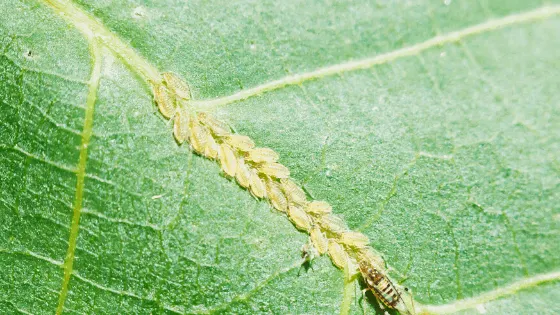
Aphids are sap-sucking pests
Large Aphid Infestations
Large aphid infestations are a little bit harder to get rid of.
One easy way to get rid of a large infestation of aphids is by using flour. Yes, you read that right. Flour.
For this method, you only have to dust your plant with flour. Don’t forget to dust under the leaves where the pests like to dwell.
When the aphids go to feed off your plant, they’ll be ingesting the flour as well.
When they consume flour, it constipates them. This clogging of the digestive system leads to the bug’s death.
Another method involves cleaning the entire plant with a special soapy mix. The best part is that You can make this special spicy soap at home.
You’ll need:
- 1/2 teaspoon of cayenne pepper
- 1 teaspoon of mild dish detergent (not soap for dishwashers)
- 1 quart of distilled water
All you do is mix all the ingredients before you apply it to your plant. You can apply it through spraying your plant or even washing your plant.
Once you apply the soap, let it sit for a few minutes. Then you need to clean it off with clean water.
The dish detergent kills most of the aphids. The cayenne pepper will repel the ones that survived.
You have to repeat this method every few days for at least three weeks. This ensures you get every single bug.
Like with most pests, insecticidal soap is a great option for getting rid of an aphid infestation.
The important ingredient in these soaps involves fatty acids. The fatty acids collapse the cells inside of the aphids.
As the cells collapse, the aphid is drying and shriving into nothing.
Using the soap on your plant is pretty easy. Spray your entire plant with it. Make sure you even get those tight spaces.
Repeat this method at least once a week for about four weeks.
Before you use insecticidal soap, you should always test your plant a day beforehand. You want to make sure there isn’t a bad reaction.
Neem oil is a popular natural pesticide. It works as a repellent for aphids and other irritating pests.
When sprayed with neem oil, plants absorb that oil.
When an aphid feeds off the plant, it’s also getting a taste of the oil. They don’t like the oil so they stop eating. When aphids don’t eat, they either die or go on their way.
Another great thing about neem oil is that it stops female aphids from laying eggs. You don’t have to worry about breeding.
Another effective method is using organic diatomaceous earth, also known as DE. You can buy DE dust at most retailers in gardens and plants.
Fossilized diatoms (an aquatic creature) make up a big part of DE. See, diatoms’ skeletons are made from silica which works as a great insecticide.
And it contains zero poisons or toxins that could harm you or your plant.
DE will steal and absorb all the oils and fats in a bug. This dries the bug out until it dies.
If all else fails, it’s time to look into a chemical treatment for your plant. This should be a last resort because you want to avoid chemicals on your plants.
There are plenty of indoor pesticides you can buy at any home and garden store.
There are times when an aphid infestation is too bad and untreatable. When that’s the case, you’ll have to dispose of the plant.
Aphids Frequently asked questions
Are aphids and mealybugs the same bug?
Aphids and mealybugs aren’t the same bugs even though they both feed off of sap. It’s a common misconception. But they come from two different bug families.
What plants can I use to lure aphids away from my plant?
There are a few great trap plants. Aphids love asters, dahlias, mustard, and zinnias.
Why is my plant still sick? I got rid of the aphids.
Most species of aphids carry plant diseases. It’s possible an aphid gave your plant a virus. The biggest symptom of all plant viruses is stunted growth.
Conclusion
Aphids are not that difficult to get rid of. It is the kind of pest that is easy to spot which is a big advantage. Since they are plant sap-sucking animals it is best to act fast. The longer you wait the harder it gets to get rid of them from my personal experience. I prefer to pick them by hand and get them off my valuable plants.

Daniel has been a plant enthusiast for over 20 years. He owns hundreds of houseplants and prepares for the chili growing seasons yearly with great anticipation. His favorite plants are plant species in the Araceae family, such as Monstera, Philodendron, and Anthurium. He also loves gardening and is growing hot peppers, tomatoes, and many more vegetables.

